Bee Hive
Bee Hive
Different Species of Honeybees and their Nesting Behavior
There are 5 types of Honey-bees found in India. 4 are Indigenous and 1 is Non-Indigenous.
Indigenous Honey bee
1. Apis cerana
- Black and Yellow striped abdomen.
- Makes 6-8 parallel combs nesting pattern in dark and cool cavities.
- Docile in nature and excellent pollinator.

2. Apis dorsata
- Golden, Black pale banded abdomen and bigger in size.
- Builds big single comb with open nesting pattern.
- Wild/Feral in nature and excellent pollinator.
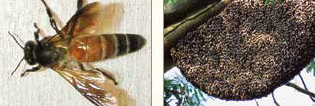
3. Apis florea
- Black and White striped abdomen and smaller in size.
- Builds small single comb with open nesting pattern.
- Wild/Feral in nature, endures high temperature and excellent pollinator.
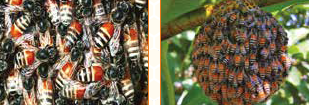
4. Trigona
- Tiny beautiful Golden Yellow/ Brown abdomen also known as ‘Stingless Bees’.
- Builds hives in pot/barrel shape cell and excellent pollinator.
- Highly social insect.

Non Indigenous Honeybee

5. Apis mellifera
- Black and Pale Yellow stripped abdomen, hairy body and docile in nature.
- Bigger than Apis cerana.
- 8-10 parallel combs nesting pattern and lives in dark and cool hives.
- Social insect and excellent pollinator.
Fun facts about Bees
- Drones : Larger than the worker bees, the male honey bees (also called drones), have no stings and do no work at all. All they do is mating. In fact, before winter or when food becomes scarce, female honeybees force surviving males out of the nest.
- Queen
- One queen runs the whole hive. Her job is to lay the eggs that will spawn the hive’s next generation of bees.
- The queen also produces chemicals (pheromones) that guide the behavior of the other bees.
- Each bee has 170 odorant receptors, which means they have one serious sense of smell !!!! They use this to communicate within the hive and to recognize different types of flowers when looking for food.
Colony Organization and Division of Labor
Worker Bees
Worker Bees are sterile female bees (also known as Half sisters).
Her major tasks are:
- Cleaning the cells.
- Feeding.
- Producing royal jelly, wax and honey.
- Building and repairing combs.
- Protecting the colony.
- Maintaining temperature inside the hive.
- Consulting, foraging (water, food, new sites).
Queen Bee
Queen Bee is known as ‘Mother of the Colony’. They are fertile female bee with elongated conical abdomen with shorter wings.
Her major task is populating the colony/lay eggs.
Drone Bees
Drone Bees are male bees with rounded abdomen and dark in color. They are bigger than worker bees but smaller to the Queen bee.
His major task is mating with Queen.
Identifying the cell structure of each members in comb
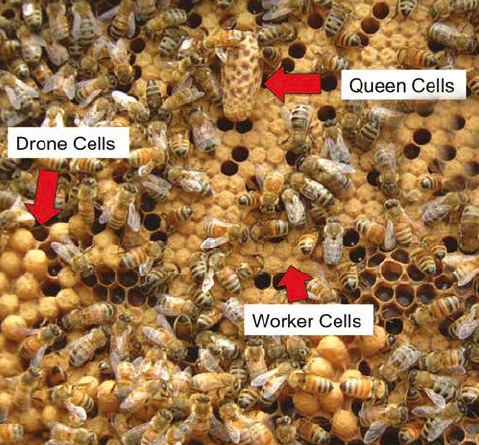
Bee's Anatomy
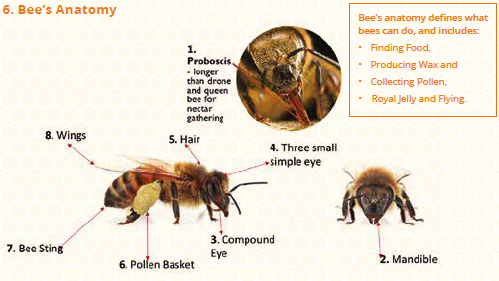
Facts to Ponder
- Tongue/Proboscis : To Suck up fluids (Liquids and Nectar).
- Mandible - To chew Pollen and Wax.
- Compound and Small Eyes - They have five eyes, two large compound eyes, one on either side of their head and three smaller eyes, called Ocelli, at the top of their heads.
- Honeybees Hair - Bees have three million hairs on their tiny bodies. Each hair is strategically placed to carry pollen and also to brush it off. The hairs found on a bee’s eye are spaced to fit one grain of pollen.
- Hind Leg - Hind legs (Pollen Basket) is used in harvesting pollen and carrying it to the nest or hive.
- Sting - A bee injects sting when threatened, stepped on or roughly handled.
- Wings - Honey bees have two sets of wings (four wings) that are attached to the thorax; the fore wings are much larger than the hind wings. The rapid wing beats of bees create vibrations in the air that the human ear detects as buzzing.
Life Cycle of Bees
Honey bees develop in four distinct life cycle phases : egg, larva, pupa, and adult. The total development time varies a bit among the three castes of bees, but the basic miraculous process is the same: 24 days for drones, 21 days for worker bees and 16 days for queens.
Life Cycle of Bees
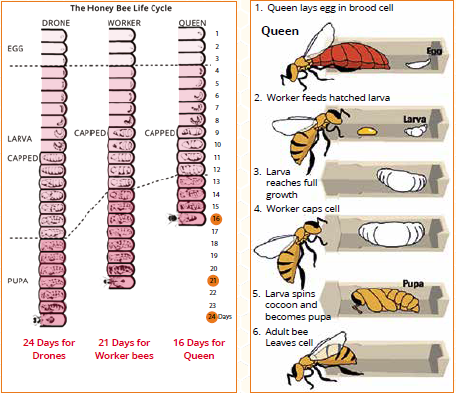
Basic Inspection of a Colony - Why and What to Inspect
The hive inspection is an opportunity for the beekeeper to dig deeper when observing the hive. Watching the bees come and go from the hive can convey important clues about the colony. However, for a real understanding, it is important that the beekeeper should open up the hive and check the followings:
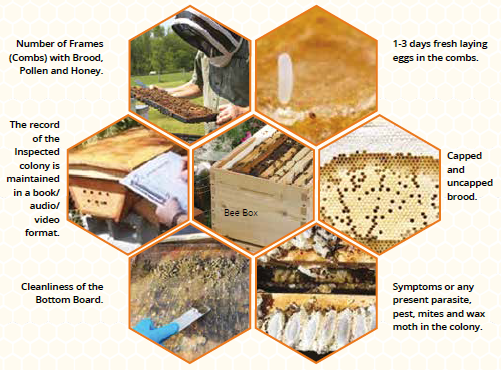
How to extract Honey from Rock & Dwarf Honeybees?
After smoking off the bees from the comb, most honey hunters cut down the whole combs destroying all the brood and food stores. A large number of young bees, some hundreds of adult bees and sometimes even a queen and drones are also killed while hunting honey.
How to Extract Honey from the wild honeybees?
- Remove only the swollen honey portion at the end side of the comb. It’s the only place honey is stored, remaining comb is filled with pollen and brood therefore keep that portion intact.
- Preferably, try to remove and extract the honey during the dusk hours of the day (5-6.30 pm) just before sunset Avoid the day time.
- Before removing the honey portion (Comb) spray warm sugar water (not too hot or cold) to sidetrack their attention on sucking up the sugar water. That’s the way to make them less ferocious.
- Slowly brush off (use soft brush) the bees to the brood side.
- Cut the honey portion and keep the remaining brood unharmed. It will provide you with more honey and also conserve and thrive our beautiful indigenous bees.
Last Modified : 1/5/2023
Provides information about Nutritive value of Hone...
This topic provides information about Wonders of B...
This articles deals with honey bee and crop :conce...
This topic provides information about World Bee Da...
